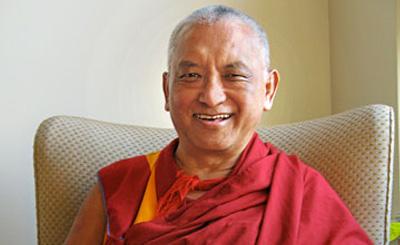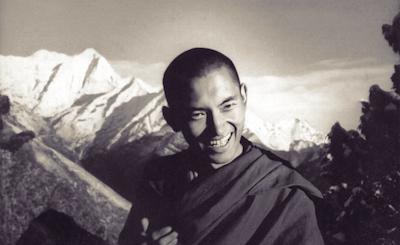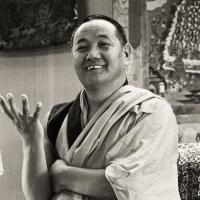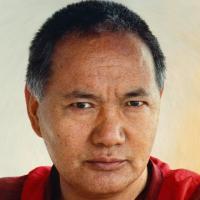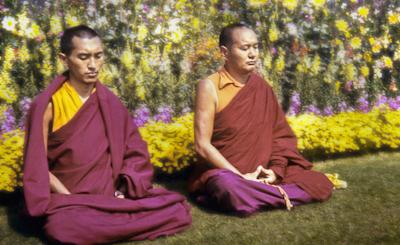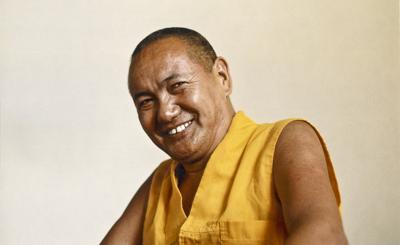December 6, 1993
More tonglen
[Refuge and bodhicitta prayers]
As I mentioned the other day, with the strong thought of bodhicitta, think, “I will take all the hell beings’ suffering on myself and experience it for them. And I will give all my happiness and all my merit to everyone, all the temporary happiness up to and including peerless happiness, full enlightenment, I will give it to everyone, to every hell being, so they receive and experience it.”
Then do the same thing with the other realms, thinking, “I will take all the hungry ghosts’ suffering and experience it for them.” And the same thing for the animals, humans, suras and asuras, thinking something like, “How wonderful it would be, how fantastic if I could experience every human being’s problems. If I could take every human being’s problems on myself and experience those problems for them and let them have all my happiness and merits, including peerless happiness, full enlightenment, how wonderful that they could receive it and experience it.”
Think like this, “How wonderful it would be if I could experience every hell being’s suffering. If I could take all their sufferings, all the unbearable, heaviest suffering in samsara, if I could take it on myself and experience it for them and let them to have all my happiness, how wonderful that would be. That is the best thing to do in my life, the most enjoyable thing, to take other sentient beings’ problems and sufferings on myself and let them have all my happiness.”
Thinking strongly in this way, recite the Compassion Buddha’s mantra. Starting from the hell beings, generate the wish to take their sufferings.
[Rinpoche and students recite OM MANI PADME HUM]
Make every action Dharma
As I mentioned yesterday, there are two factors with the things we do in our daily life: the external action and the attitude. We need to know how to live our life, how to do every single external action with the correct attitude. Since what we like is happiness and what we don’t want is suffering and problems, that depends on the attitude we have for every single action we do.
If every activity is done with an attitude that is Dharma, with non-anger, non-ignorance, and in particular, with non-attachment, we are living our life or doing these activities with a positive attitude, with a mind that becomes Dharma. Then, all the actions become Dharma and the unmistaken cause of happiness. Knowing how to live our life, knowing how to do everything, of the external action and the internal attitude, the main thing, the most important thing, is the attitude.
If our attitude is one of nonvirtue, of ignorance, anger or attachment, then all the activities become nonvirtue, no matter how expert we might be in the external performance of the action, no matter how qualified we are or how much education we have in how to do external activities. In reality, all the activities become the cause of suffering because our attitude did not become Dharma.
No matter how much education we have, how expert we are at doing things externally, that alone doesn’t make the action become the cause of happiness; that alone cannot transform the action into virtue, into Dharma, the cause of future lives’ happiness, the cause of ultimate happiness, liberation from samsara, the cause of peerless happiness, full enlightenment.
The action does not bring us happiness, only suffering. The result of the action is exactly what we don’t want to experience. Therefore, the main thing, the most important thing we must do in our life is to understand that all happiness, peace and success come from making our attitude positive so it becomes Dharma. As I mentioned before, this good heart becomes the most important education, the very first thing to be known, to learn, to practice, otherwise whatever we do becomes an obstacle to happiness and a cause of suffering.
Avert delusions as soon as they arise
In our day-to-day life, any experience of happiness or success is due to past good karma. It has come from past good karma, which is positive intention, one of the five omnipresent mental factors that always accompany the principal consciousness. What is karma, action? It is intention, this mental factor from among the fifty-one mental factors, one of the omnipresent mental factors: intention, feeling, contact, discrimination and attention. In Tibetan, intention is sempa.
The fifty-one mental factors are divided into: the eleven virtuous mental factors, such as devotion, shyness, shame and so forth; the six root delusions; the twenty secondary delusions and the four changeable mental factors. Then there are the five omnipresent mental factors and the five object-determining mental factors. Of the five mental factors that always accompany the principal consciousness, one is intention, sempa. That’s what karma is, action. Karma is a Sanskrit word, which translates into English as “action,” but it refers to this mental factor, intention. Of the two divisions of body and mind, it is mind.
Suffering and happiness; enlightenment and hell; samsara and nirvana, the lower suffering realms and the upper happy realms; the body of a suffering transmigratory being and the body of a happy migratory being—all these come from our own mind, from the action, karma, the intention on our mindstream. Suffering results from negative, nonvirtuous intention and happiness results from positive, virtuous intention, so both suffering and happiness come from this.
In Buddhist psychology, there are said to be six principal consciousnesses, although the Mind Only school asserts a seventh principal consciousness or even an eighth, last one called the “mind basis of all.” Generally speaking, however, of body and mind, within mind there are six principal consciousnesses and fifty-one mental factors.
All happiness and suffering is dependent on the attitude, the intention, which is karma. It all depends on what kind of intention we generate. As the great bodhisattva Shantideva mentioned in A Guide to the Bodhisattva’s Way of Life,
Even those who wish to find happiness and overcome misery
Will wander with no aim nor meaning
If they do not comprehend the secret of the mind—
The paramount significance of Dharma.2
Those who do not know the secret of the mind means those who don’t know how all happiness and suffering and all those things I mentioned, enlightenment, hell and so forth, everything is rooted on, everything depends on our own mind, on what kind of attitude we have. Everything depends on the motivation, the attitude, the intention.
If we don’t know the secret of the mind, how it is the motivation that produces suffering or happiness, no matter how much we wish to achieve happiness, no matter how much we wish to avoid problems, sufferings, we will continue to wander in samsara, in the six realms, without any purpose. Being under control of this ignorance, sentient beings wander in samsara, having to continuously experience all those sufferings again and again and again.
In the next verse, Shantideva said,
This being so,
I shall hold and guard my mind well.
Without the discipline of guarding the mind,
What use are many other disciplines?3
This is the same as what is explained in the third verse of Eight Verses of Mind Training,
Vigilant, the moment a delusion appears in my mind,
Endangering myself and others,
I shall confront and avert it
Without delay.
In the Tibetan there is the word tsän thab, which literally means diligently, although there may be different translations. It has the sense of doing something immediately, without delay, maybe also with effort. Then it says to dispel or avert the delusions. How? By practice, by applying the path, by developing both method and wisdom as is explained in the teachings of the Steps of the Path to Enlightenment. For example, attaining the renunciation of samsara and bodhicitta and so forth are the method side of the Dharma, whereas the meditation on emptiness is the wisdom side. By realizing emptiness, with that wisdom, we immediately dispel and destroy the delusions.
For example, if we see a thief about to enter our house to steal things, even before they get inside, we hit them! Before they have a chance to crush us, to smash us, to blow us up with a bomb or hit us over the head with a hammer—before the thief, the enemy can destroy us—without delay we crush them or destroy them. In the same way, if we allow a delusion to arise, such as anger, it destroys all our merit, the most precious wealth we can have, the cause of all happiness. Therefore as soon as we see a delusion arising, we must avert it without delay. As Shantideva said in A Guide to the Bodhisattva’s Way of Life,
Doing virtuous actions
Such as charity or making offerings
Accumulated for a thousand eons
Is destroyed by one second of anger arising.4
If we delay for even a second trying to destroy the inner enemy, the delusion, anger, there is danger the anger will destroy our merit, destroy our liberation, destroy our enlightenment, destroy our happiness for a thousand eons.
So, this is the most basic and most important way of practicing Dharma—continuously watching our mind and protect it from the delusions that are the cause of all the sufferings.
Practicing Dharma is the most important education
The way we can protect ourselves from suffering and be able to always keep the mind in Dharma is by watching our mind like this. Then, all our actions become Dharma; they become only the cause of happiness—the happiness of future lives, of liberation and of full enlightenment. When we practice Dharma like this, we become a guide for ourselves; we guide ourselves all the way to enlightenment.
If we didn’t have ignorance, anger, attachment, and all the delusions, if we were free from all the hallucinations, from all the mistakes of the mind, then we could say, “I want to be myself, I don’t want to become any other thing,” because we would have already achieved liberation, freedom from the whole cause of suffering, delusions and karma, and there would be no way to ever experience suffering again. And after having become enlightened, having ceased even the subtle obscurations, there would be no cause to ever become a deluded samsaric being again.
However, until we have ceased all the mistakes of the mind, all the gross and subtle obscurations, to say that we want to be ourselves means we don’t want to develop our mind, we don’t want it to become better. Maybe somebody who doesn’t want a better quality of life doesn’t know what they are talking about. That is basically due to ignorance. What does “I want to be myself” mean? It means to live with delusions.
So, if we let ourselves live our life without watching the mind, there is no protection for the mind, and we must live our life with delusions, which constantly create the cause of suffering. Then, we will continuously be a samsaric being, continuously creating the causes of suffering and continuously experiencing the results of suffering. This is what happens when we just “be ourselves.”
Without Dharma practice, because our mind is always under the control of delusion, it becomes the creator of our own suffering. Because of this, our mind becomes our enemy, the one who creates all our problems.
Therefore, watching the mind, transforming the mind into the three principal aspects of the path, becomes the most important education. It teaches us how to live our life, how to do everything. The best motivation for everything we do is bodhicitta. Living our life with that attitude brings the greatest benefit; it makes life most beneficial for ourselves and for all living beings. With a bodhicitta attitude, every activity we do during twenty-four hours becomes the cause of enlightenment: eating, walking, sitting, sleeping, working, talking, washing and so forth.
If that motivation is not possible, then the next best one is to live with the mind transformed into Dharma, with the renunciation of samsara, with a mind that is free from the attachment clinging to samsara. Then, all our actions become the cause to achieve liberation. For example, doing a breathing meditation with that motivation becomes the cause to achieve liberation for ourselves.
If even that is not possible, we can transform the mind into Dharma with the renunciation of this life, with the mind that is free from attachment clinging to this life, so at least the action of doing breathing meditation becomes the cause for the happiness of future lives.
How we live our life depends on the capacity of our mind, which level of positive motivation we can have that makes our life meaningful, not empty, which it is when our attitude is attachment clinging to this life, the attitude that creates the cause of suffering, particular the suffering of the lower realms. That nonvirtuous worldly mind not only makes our life empty, it is just creating the cause of suffering. Therefore, understanding [the difference between what is Dharma and what is non-Dharma] becomes the most important education on how to live our life, how to do everything.
This year, when I was flying between Hong Kong and London, I was listening to a young Indian man behind me talking to his friend. They talked for the whole flight. I remember when the plane landed and stopped, just before we got off, he told his friend that nobody knows how to do anything. I don’t think he was talking about any complicated things. Then I thought, it is not that nobody knows anything, but in another sense what he said was very true, although he possibly wasn’t sure of the point he was trying to make. I think he showed he was quite intelligent and that he was not talking about external things but something more than that.
Emptiness of the E
Everything comes from the mind. Before being taught something, before something is introduced to us by a teacher, we don’t know anything. For instance, when we were a child learning the alphabet, before somebody introduced a letter to us, such as the letter E, they were just four lines on a page. There were the lines but they didn’t have the appearance of an E. The top line didn’t appear as an E, the middle line didn’t, the bottom line didn’t, the line at the side didn’t appear as an E and all the lines together didn’t appear as an E. At first, we just saw the design as lines, not as an E.
Why didn’t we see that this is an E? Because we didn’t have the appearance of this as an E, and this was because our mind hadn’t labeled that design as an E and believed it to be that. Later, when somebody told us that this is an E, then, by accepting that, we made up the label “E” and believed in that. Because of that, there is the appearance of an E—that this is E—and we see it as an E. So there is this whole evolution, starting from our mind making up the label and believing in that. We made up the label because we followed somebody’s introduction, and then we believed in that.
We see the lines first and then we make up the label “E.” Therefore, on these lines—on this base, on this design—there is no E. Before we label “E” we have to see something first. We have to see something and then to reason in our mind before we choose this particular label “E.” The base, the design, is the reason, and we see the base first before seeing the E, which is the label in the evolution.
This proves these lines are not an E. There is no E. We cannot find an E anywhere on these lines because there is no E existing on them. This is similar to what we talked about before with the tea.
The main thing to understand is that the E is not there until our mind makes up the label and believes in it. We have to have a reason, and the reason is seeing something first—the base, the design, the lines—and then, after that, we label it “E.” So, the first time we see the base, before deciding to label it “E” there is no E. If there was an E on the design we should be able to find it from the very beginning, at the very same time we see the base. However, this doesn’t happen.
And also, if what we saw from the very beginning was an E rather than just the base, there would be no reason to label it “E.” It doesn’t make sense; there is no reason to label it “E” afterwards, meaning we add the label “E” to what is already an E. Then, what about that label? We would have to label that and then we would have to label the label of the label, so it becomes meaningless.
The design is not the E; we cannot find the E there at all. So, the base—the design—and the label—the E—are different. So now, what is E? The E is what is merely labeled by mind. The reason [we label the E] is because we see the design, these lines. That’s what the E is, merely labeled by mind.
One conclusion here is that the E comes from our mind, and the other conclusion to understand is that the E is completely empty of existing from its own side. This is not the way the E normally appears to us. It appears as existing from its own side, but that is a complete hallucination. That is the false view. The E that is there on the design, the E that appears from its own side, this is the refuting object, this is the hallucination.
With this example we see that there is no E on this base, we cannot find the E anywhere on this design. The other thing is the E came from our own mind; it is a creation of our mind. The third thing is that the E doesn’t exist from its own side at all. This emptiness is the ultimate nature of the E, the E that is empty of existing from its own side. So this example leads us to understand these three points.
We suffer when our ego doesn’t get what it wants
The other night I put the question the wrong way. I didn’t think about my words well, which is often the case! The other night I think I said something like who hurts us, but that was wrong. I should have said who causes others to hurt us. That was the question.
Of course, normally we say it’s karma. Those of us who have heard the teachings, whether we really understand karma or not, we say it’s karma. But the question is what makes others hurt us. The usual explanation of karma is that what makes others hurt us comes from our own mind. It’s our own concept that makes others hurt us.
The essence is that while we follow ego and attachment, clinging to this life, anything the ego doesn’t expect or like, anything of the person’s actions of body, speech and mind that the ego doesn’t expect or want, it labels as bad. Let’s say a friend does something that the ego doesn’t like. Usually they praise us and the ego, attached to happiness, is pleased. This is what the ego expects. But if that friend does the opposite—criticizing us, disrespecting us, treating us badly physically or verbally—then the ego labels this as “anger” and the friend as not loving us. Because this is not what the ego wants, what our attachment wants, it hurts us. What that friend is doing is hurting our ego, our attachment that clings to the happiness of this life. It hurts the worldly mind. The ego thinks this shouldn’t happen.
If we didn’t follow the ego, if we didn’t follow attachment, if we weren’t a friend to ego and attachment, then these things wouldn’t hurt us. Because we are a friend to our ego, however, we see the things our friend has done, such as criticizing us, not as harming our ego but as harming us.
So, now we can see that not only does the harm others do to us come from our own mind, but also the big mistake we make is by following the ego and attachment. If we didn’t follow the ego, even if these things hurt our ego and attachment, they wouldn’t hurt us. When somebody does something contrary to what the ego expects and wants, it becomes a problem because it’s something the ego has interpreted as “harmful” and therefore we make up the label “bad” for the person doing it. The ego creates these labels—"harmful situation” and “bad person”—and we have these appearances. And it’s similar with our attachment.
Just as a physical action can be interpreted as harmful, what somebody says to us can be seen as harmful. It’s just an arrangement of words, just things said in a different way, but one way the ego interprets as good and the other way it interprets as bad or harmful and then sees the person as bad. And mentally, the ego interprets the person’s attitude as good or bad. It’s just another concept. It sees the person in one way and labels “loving” or “attractive”, but something changes and it then labels them as “bad” and “harmful” and they appear to us as bad and harmful.
When we don’t analyze what is happening, seeing how all these things are concepts of the ego, of the attachment, just projections, it looks like somebody disrespects us and there is real harm coming from a bad person. It comes purely from outside and has nothing to do with our mind, with our concept. The person’s physical action seems to come purely from outside; what they say seems to come purely from outside; their attitude seems to come purely from outside.
This is totally wrong. It is a total hallucination. We are totally mistaken because what appears to us as happening and what we believe to be happening is the complete opposite to what is actually happening. The harm we perceive as coming from outside only comes from our own mind, from our ego and attachment. It’s our own concepts that harm us. That is the real essence, without talking about past karma, without talking about long-term causes from this or previous lives, just what’s happening right now with our mind, what our mind is creating..
The other proof is that these things—the disrespect, abuse, criticism, how the other person doesn’t love us—don’t bother us when our mind is free from attachment to this life. What they do to us doesn’t hurt us, doesn’t hurt this other mind, the one detached from this life. And it doesn’t hurt the mind of bodhicitta, the mind cherishing other sentient beings. It doesn’t hurt the mind of compassion, because compassion wishes all sentient beings to be free from suffering and wants to help others, no matter how they treat us.
We can only practice patience with those who harm us
Especially when we are practicing patience, from the point of view of the patience, this person who treats us badly with their body, speech and mind is the kindest, most precious person we have even found in our life.
No matter how much wealth we have, how much reputation or power we have, how many friends we have, if we do not practice patience there is no peace or happiness in our life. But by practicing patience there is so much peace and happiness in the heart, whether we have a reputation or not, whether we have power or not. Even if we don’t have one single friend, when we practice patience there is very deep peace, happiness and joy in our heart. We can’t get this deep peace and joy from wealth, power, reputation—even friends—that we get from practicing patience.
But here, we only get to practice patience with this person, the one who doesn’t love us. There is no opportunity to practice patience with the buddhas because they never have the slightest anger toward us. Likewise, with our friends, those people who like us, and even strangers—those who don’t have anger toward us—we have no opportunity to practice patience with. The only person who gives us the opportunity to practice patience is the person who is angry with us, who doesn’t love us.
Without practicing patience there is no way to complete the path to enlightenment, to complete the cessation of all the mistakes of the mind and attain all the realizations. There is no way to free every living being from all the sufferings and lead them to peerless happiness, enlightenment. All these infinite qualities of a buddha to benefit all sentient beings only come from completing the whole path, which means attaining the paramita, the perfection of patience. Patience is an essential aspect of the path to enlightenment, so without completing it, it is impossible for all these things to happen. Therefore, by being angry with us, this person gives us the opportunity to practice and enables us to complete the whole path, to become a buddha and be able to benefit all sentient beings. So this person is giving us all these infinite benefits that come from practicing patience, benefits like the limitless sky.
Because they are extremely kind in this way, we must thank them, we must repay them for what they are giving us, but many universes, many galaxies filled with mountains of gold, diamonds and all sorts of jewels cannot start to repay that kindness. Even if we make offerings to this person of all this, it is nothing compared to the infinite benefit we are receiving from them. They are so kind, so precious. We couldn’t get the deep peace and joy we would have from practicing patience even if they were to give us millions of dollars or even if we were to give them millions of dollars. This is nothing compared to the peace and joy that patience brings. We can’t get the deep peace we receive from this person from anything else, no matter how many friends or how much wealth or power we have. So this person is very precious.
[All our suffering comes from] following the ego, the self-cherishing thought, the delusions, and by being angry with us, this person is helping us destroy the ego, the delusions. So, how kind they are, how precious. From the point of view of patience, they are the kindest, the most precious. We currently see what they are doing to us, criticizing us or whatever, as bad and we see them as not loving us. We can change how we see that, by seeing how it in no way hurts our patience and in fact helps us develop it, so in that way the person is benefiting us, supporting us in developing our mind toward enlightenment. This person is actually giving us enlightenment. Their actions can never harm us, in the view of patience.
If we follow patience, if we follow loving kindness, compassion, bodhicitta, if we follow the renounced mind, we don’t see this person as harming us; we don’t see them as bad. We have a completely different view of them when we follow these other positive minds, these peaceful, healthy minds.
Now, it becomes very clear that the harm comes from our own concepts. We believe those concepts and think that the other person is harming us. The harm is a creation of our own mind and so it’s the concepts within our own mind that are harming us.
So, I think one aim of this talk has already happened. I’ll stop here.
Notes
2 Ch. 5, v. 17. [Return to text]
3 Ch. 5, v. 18. [Return to text]
4 Ch. 6, v. 1. [Return to text]







